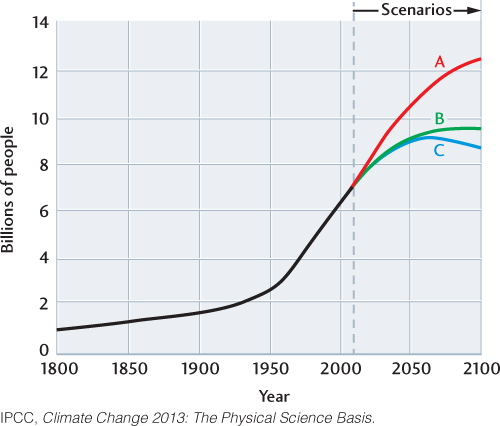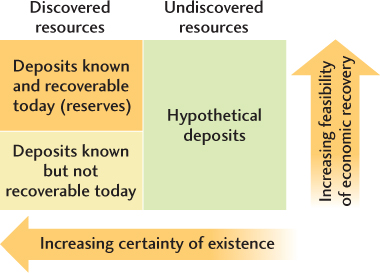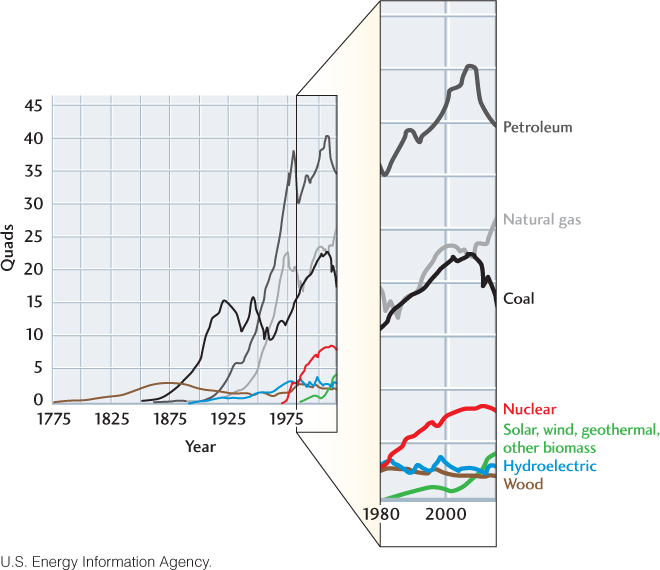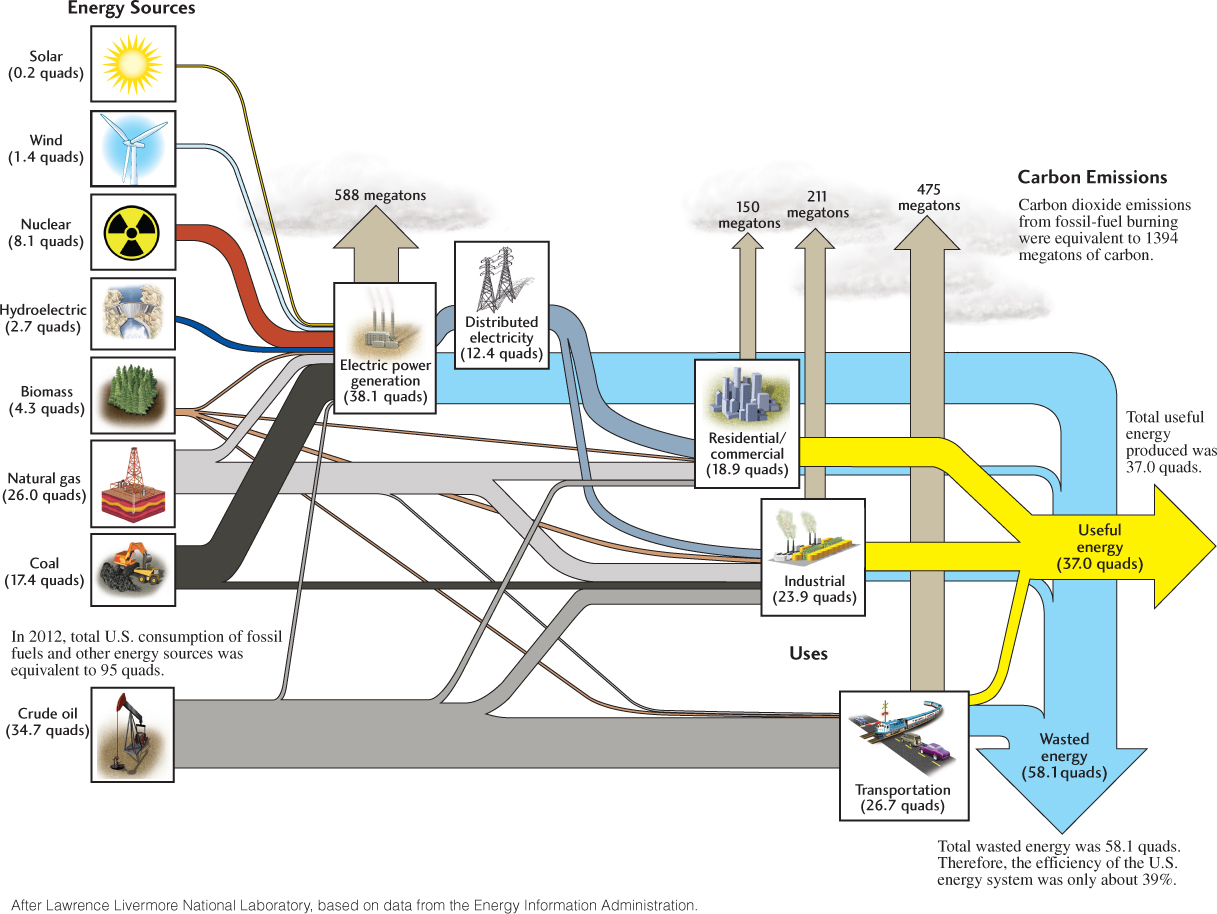Civilization as a Global Geosystem
The human habitat is a thin interface where Earth meets sky, where the global geosystems—the climate system, the plate tectonic system, and the geodynamo—interact to provide a life-sustaining environment. We have increased our standard of living by discovering clever ways to exploit this environment: to grow food, extract minerals, build structures, transport materials, and manufacture goods of all kinds. One result has been an explosion in the human population.
Early in the Holocene, about 10,000 years ago, when the climate was warming and agriculture first began to flourish, roughly 100 million people were living on the planet. Population grew slowly. The first doubling, to 200 million, was achieved early in the Bronze Age, about 5000 years ago, when humans first learned how to mine ores and refine them into metals such as copper and tin (of which bronze is an alloy). The second doubling, to 400 million, was not achieved until the Middle Ages, about 700 years ago. But once industrialization began, in the early nineteenth century, the global population really took off, climbing to 1 billion in about 1800, 2 billion in 1927, and 4 billion in 1974. By the mid-twentieth century, the doubling time for the human population had dropped to only 47 years—less than a human lifetime. The world population exceeded 7 billion in early 2012, and, although its growth rate is expected to decline, the total will almost surely top 8 billion by 2030 (Figure 23.1).

As our population has exploded, our appetites for energy and other natural resources have become voracious. The demand for natural resources is skyrocketing as civilization expands and people around the world strive to improve the quality of their lives. Our energy usage, for example, has risen 1000 percent over the last 70 years and is now increasing twice as fast as the human population. The view of Earth from space in this chapter’s opening photograph shows a glowing lattice of highly energized urbanization spreading rapidly across the planet’s surface.
Human civilization has altered the environment by deforestation, agriculture, and other land-use changes since it began. But our effects in earlier times were usually restricted to local or regional habitats. Today, energy production on an industrial scale makes it possible for humans to compete with the climate system and the plate tectonic system in modifying Earth’s surface environment, as illustrated by some startling observations:
 Dams and reservoirs built by humans now trap about 30 percent of the sediments transported down the world’s rivers.
Dams and reservoirs built by humans now trap about 30 percent of the sediments transported down the world’s rivers. In most developed countries, construction workers move more tons of soil and rock each year than do all natural erosional processes combined.
In most developed countries, construction workers move more tons of soil and rock each year than do all natural erosional processes combined. Within 50 years after the invention of the artificial coolant freon, enough of it had leaked out of refrigerators and air conditioners and floated into the upper atmosphere to damage Earth’s protective ozone layer.
Within 50 years after the invention of the artificial coolant freon, enough of it had leaked out of refrigerators and air conditioners and floated into the upper atmosphere to damage Earth’s protective ozone layer. Humans have converted about one-third of the world’s forested area to other land uses, primarily agriculture, in the last half century.
Humans have converted about one-third of the world’s forested area to other land uses, primarily agriculture, in the last half century. Since the industrial revolution began in the early nineteenth century, deforestation and the burning of fossil fuels have increased the concentration of carbon dioxide in the atmosphere by almost 50 percent.
Since the industrial revolution began in the early nineteenth century, deforestation and the burning of fossil fuels have increased the concentration of carbon dioxide in the atmosphere by almost 50 percent.
We are not just part of the Earth system; we are transforming how the Earth system works, perhaps in fundamental ways. In a geologic instant, human civilization has developed into a full-fledged global geosystem.
Natural Resources
The term natural resources refers to the energy, water, and raw materials used by human civilization that are available from the natural environment. Renewable resources are those natural resources that are continually produced in the environment; for example, if we chop down a forest for wood, it can be regrown and harvested again. Nonrenewable resources are those natural resources that we are using up much faster than they are being produced by geologic processes. Organic material must be buried and heated for millions of years, for example, to produce petroleum.
643
The supply of any material we take from Earth’s crust is finite. Its availability depends on its distribution in accessible deposits, as well as on how much we are willing to pay to get it out of the ground. Geologists use two measures to describe the supply of these nonrenewable resources. Reserves are deposits of a given material that have already been discovered and can be exploited economically and legally at the present time. In contrast, resources comprise the entire amount of the material, including the amount that may become available for use in the future. Resources include reserves plus known but currently unrecoverable supplies plus undiscovered supplies that geologists think may eventually be found (Figure 23.2).

Reserves are considered a dependable measure of supply as long as economic and technological conditions remain constant. As conditions change, some resources become reserves, and vice versa. In many cases, resources that are too poor in quality or quantity to be worth exploiting, or that are too difficult to retrieve, become reserves when new technology is developed or prices rise.
Geologists are experts at discovering new resources. It should be kept in mind, however, that the assessment of resources is much less certain than the assessment of reserves. Any figure cited as representing the resources of a particular material is only an educated guess as to how much will be available in the future. We can better understand how to manage our natural resources by considering the geologic circumstances in which they are found and the problems related to their recovery and use.
Energy Resources
Energy is required to do work, so it is fundamental to all aspects of human civilization. A crisis in the supply of energy can bring a modern society to a halt. Wars have been fought over access to supplies of fuel; economic recession and destructive currency inflation have resulted from fluctuations in the price of oil and other fuels.
Our energy use has been increasing over the last two centuries, but our energy sources have also been changing since the industrial revolution began (Figure 23.3). A century and a half ago, most of the energy used in the United States came from the burning of wood. A wood fire, in chemical terms, is the combustion of biomass—organic matter consisting of carbon and hydrogen compounds. Biomass is produced by plants and animals in a food web that is based on photosynthesis. Thus, the ultimate source of the energy in wood is the sunlight plants use to convert carbon dioxide and water into carbohydrates. Combustion of wood or other biomass produces heat energy and returns carbon dioxide and water to the environment. In this capacity, the biomass acts as a short-term reservoir for storing solar energy. It is a renewable energy resource because the biosphere is constantly producing new biomass. Before the mid-nineteenth century, the burning of wood and other biomass derived from plants and animals (e.g., whale oil, dried buffalo dung) satisfied most of society’s need for fuel. Even today, the energy derived from biomass equals the total derived from all other renewable resources.

644
Some of the biomass that was buried in sedimentary rock formations millions of years ago, particularly during the Carboniferous period, has been transformed into a combustible rock called coal. When we burn coal, we are using stored energy from Paleozoic sunlight. Thus, the primary source of this “fossilized” energy is the same solar power that drives the climate system. Our other major fuels, crude oil (petroleum) and natural gas, are also created by diagenesis and metamorphism of dead organic matter. Coal, oil, and natural gas are known collectively as fossil fuels. At current rates of use, our reserves of these nonrenewable energy resources will be exhausted long before geologic processes can replenish them.
Rise of the Carbon Economy
Humans have used a variety of renewable energy sources to power mills and other machinery for thousands of years, including wind, falling water, and the work of horses, oxen, and elephants. By the late eighteenth century, however, industrialization was increasing the demand for energy beyond what these traditional renewable sources could supply. At about that time, James Watt and others developed coal-fired steam engines that could do the work of hundreds of horses. Steam technology lowered the price of energy dramatically, in part because it made coal mining possible on a large scale. The availability of cheap energy sparked the industrial revolution. By the end of the nineteenth century, coal accounted for more than 60 percent of the U.S. energy supply (see Figure 23.3).
The first oil well was drilled in Pennsylvania by Colonel Edwin L. Drake in 1859. The idea that petroleum could be profitably mined like coal provoked skeptics to call the project “Drake’s Folly” (Figure 23.4). They were wrong, of course: by the early twentieth century, oil and natural gas were beginning to displace coal as the fuels of choice. Not only did they burn more cleanly than coal, producing no ash, but they could be transported by pipeline as well as by rail and ship. Moreover, gasoline and diesel fuels refined from crude oil were suitable for burning in the newly invented internal combustion engine.

645
Today, the engine of civilization runs primarily on fossil fuels. Taken together, oil, natural gas, and coal account for 85 percent of global energy consumption. We can fairly call the civilization fed by this energy system a carbon economy.
Global Energy Consumption
Energy use is often measured in units appropriate to the fuel—for example, barrels of oil, cubic feet of natural gas, and tons of coal. But comparisons are easier if we use a standard unit of energy such as the British thermal unit (Btu). One Btu is the amount of energy needed to raise the temperature of 1 pound of water by 1°F (1054 joules). When we measure large quantities, such as a nation’s annual energy use, we use units of 100 quadrillion (1015) Btu, or quads.
In 2012 the United States used about 95 quads of energy (Figure 23.5), compared with a global total of 530 quads. Thus, the United States, with 4.5 percent of the world’s population, consumes about four times more energy per person than the global average. Fossil fuels provided 82 percent of that total, and renewable biomass accounted for another 4.5 percent. You will notice that the flow of energy through this system is not particularly efficient: about 39 percent of the energy performed useful work, while 61 percent was wasted. You can also see that the system released about 1.4 gigatons (Gt) of carbon into the atmosphere in 2012, primarily as CO2 (1 Gt = 1 billion tons = 1012 kg).

There are promising signs that new energy-efficient technologies and increasing energy conservation are beginning to lessen U.S. energy appetites. In fact, the total annual U.S. consumption of energy of all types dropped by 6 percent between 2007 and 2012, the first multiyear drop in recent history. On a global basis, however, modest reductions in energy consumption by the United States, Japan, and Western Europe have been more than offset by increases in the developing world, led by the world’s two most populous countries, China (18 percent per year) and India (17 percent per year). In 2007, China’s total energy consumption exceeded that of the United States for the first time. Still, China’s average individual (or per capita) energy use remains almost eight times less, owing to its much larger population. As China and other developing economies strive to improve their standards of living, global energy use per capita is bound to rise, accelerating overall energy consumption. Global annual energy consumption is projected to exceed 600 quads by 2020 (Figure 23.6).
646

Energy Resources for the Future
Figure 23.7 gives a rough estimate of the world’s remaining fossil-fuel reserves. Simply dividing total reserves (about 53,000 quads) by the current global annual consumption estimate from Figure 23.6 (about 530 quads) might lead one to conclude (mistakenly) that many decades’ worth of resources remain before we have to worry about depletion of our energy supplies. The economics of this issue are much more complicated, however, as we will see in the rest of this chapter. Some energy sources will give out before others, the various sources of energy are not readily interchangeable, and the environmental costs of converting some of them into useful forms of energy may be too great.

Of course, we may begin to meet our energy needs through increased efficiency in the use of fossil fuels and through the development and use of alternatives such as nuclear power and renewable energy sources. Current projections indicate that energy production from renewable sources, such as solar, wind, water, and geothermal power and biofuels, will fall short of our needs for many decades to come, unless there are unanticipated technological breakthroughs. Even so, developing alternative energy sources would reduce the pressure on our fossil-fuel resources as well as their negative environmental effects.
Carbon Flux from Energy Production
One of the most serious environmental costs of using fossil fuels may be climate change caused by the influence of our carbon economy on the global carbon cycle. In the prehuman world, the exchange of carbon between the lithosphere and the other components of the Earth system was regulated by the slow rates at which geologic processes buried and unearthed organic matter. This natural carbon cycle has been disrupted by the rise of the carbon economy, which is now pumping huge amounts of carbon from the lithosphere directly into the atmosphere. As we saw in Chapter 15, the climate system is tightly coupled to the global carbon cycle because carbon dioxide is a greenhouse gas. The concentration of this gas has risen rapidly from its preindustrial level of about 270 ppm, reaching 400 ppm in 2013. If the burning of fossil fuels continues unabated, the amount of CO2 in the atmosphere will double its preindustrial level by mid-century.
Anthropogenic increases in carbon dioxide and other greenhouse gases have already led to enhancement of the greenhouse effect and global climate warming. It is clear that the future of the climate system and its living component, the biosphere, depends on how our society manages its energy resources, which we will now consider in more detail.